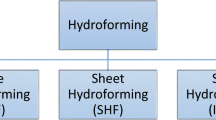Abstract
Based on the inert metal perforation plate acted as both mandrel and mask, a hybrid electrochemical fabrication process combining electroforming and mask electrochemical machining was proposed to manufacture metal through-hole arrays with double tapered openings. The feasibility of this novel hybrid process was first investigated theoretically according to developed numerical models, and then, the effect of structure parameters of the inert metal plate on profile characteristics of the through-hole being processed was numerically analyzed where optimal structure parameters were further determined. Subsequent experimental results, on the whole, agreed with those from numerical analysis. Research results showed that the profile characteristics of the shaped through-hole were significantly dependent on the structure parameters of the inert metal plate used. Smaller through-holes with a better symmetry between the opening profiles can be achieved if the inert metal plates with bigger thickness and larger hole wall angle were used. With the reduction of hole spacing in the inert metal plate, the achievable aspect ratio of the machined through-hole gradually increased, and the profile symmetry between entry and exit became better. With the increase of hole size of the patterned inert metal plate, the thickness limitation of the through-hole plates that can be achieved rose, but the minimum diameter tended to be smaller and the symmetry worsened. In addition, nonconventional inward horn-shaped profile can be shaped in the mask electrochemical machining step only when the inert metal plates having small hole spacing and hole wall angle are utilized. With a diameter deviation between the entry and the exit, 9.7 % and an expanding rate 110.1 %, favorable through-holes featuring good opening profile symmetry (88.8 %) and smooth surfaces can be machined using this hybrid process.
Similar content being viewed by others
References
Wang W, Zhu D, Allen DM, Almond HJA (2008) Non-traditional machining techniques for fabricating metal aerospace filters. Chin J Aeronaut 21(5):441–447
Datta M, Landolt D (2000) Fundamental aspects and applications of electrochemical microfabrication. Electrochim Acta 45(15):2535–2558
Bhattacharyya B, Munda J, Malapati M (2004) Advancement in electrochemical micromachining. Int J Mach Tool Manuf 44(15):1577–1589
Sen MH, Shan HS (2005) A review of electrochemical macro- to micro-hole drilling processes. Int J Mach Tool Manuf 45(2):137–152
Kern P, Veh J, Michler J (2007) New developments in through-mask electrochemical micromachining of titanium. J Micromech Microeng 17(6):1168
Zhu D, Qu NS, Li HS, Zeng YB, Li DL, Qian SQ (2009) Electrochemical micromachining of microstructures of micro hole and dimple array. CIRP Ann 58(1):177–180
Wang W, Zhu D, Qu NS, Huang SF, Fang XL (2010) Flow balance design and experimental investigation on electrochemical drilling of multiple holes. Acta Aeronaut Astronaut Sin 31(8):1667–1673 (in Chinese)
Mcgeoug JA, Leu MC, Rrjurkar KP, De Silva AKM, Liu Q (2001) Electroforming process and application to micro/macro manufacturing. CIRP Ann 50(2):499–514
Ming PM, Li YJ, Wang YL, Jiang WJ (2011) Fabrication of micro-precision sieves with high open area percentage using micro-electroforming method. Electromach Mould 4:43–46 (in Chinese)
Datta M, Romankiw LT (1989) Application of chemical and electrochemical micromachining in the electronics industry. J Electrochem Soc 136(6):285C–292C
Datta M (1998) Microfabrication by electrochemical metal removal. IBM J Research Devel 42(5):655–670
Heidborn E (1982) Process for manufacturing screens for centrifugals, particularly working screens for continuously operating sugar centrifugal. U.S. Patent No.4,341,603
Wang LX, You YF (2003) Research progress in nickel screen. Print Dye 29(9):47–48 (in Chinese)
Jackson MJ, Neill WO (2003) Laser micro-drilling of tool steel using Nd:YAG lasers. J Mater Process Technol 142(2):517–525
Meijer J (2004) Laser beam machining (LBM), state of the art and new opportunities. J Mater Process Technol 149(1–3):2–17
Diver C, Atkinson J, Helml HJ, Li L (2004) Micro-EDM drilling of tapered holes for industrial applications. J Mater Process Technol 149(1–3):296–303
Abbas NM, Solomon DG, Bahari MF (2007) A review on current research trends in electrical discharge machining (EDM). Int J Mach Tool Manuf 47(7–8):1214–1228
Bilgi DS, Jain VK, Shekhar R, Mehrotra S (2004) Electrochemical deep hole drilling in super alloy for turbine application. J Mater Process Technol 149(1):445–452
Ming PM, Lv ZB, Li HG (2012) A method of fabrication micro-perforation array with double tapered openings. CN Patent No. 201210233224.8 (in Chinese)
Hu YY, Zhu D, Li HS (2010) Fabrication of metal micro hole array by using over-plating technology. Opt Prec Eng 18(8):1793–1800 (in Chinese)
West AC, Madore C, Matlosz M, Landolt D (1992) Shape changes during through-mask electrochemical micromachining of thin metal films. J Electrochem Soc 139(2):499–506
Datta M (1995) Fabrication of an array of precision nozzles by through mask electrochemical micromachining. J Electrochem Soc 142(11):3801–3805
Shenoy RV, Datta M (1996) Effect of mask wall angle on shape evolution during through-mask electrochemical micromachining. J Electrochem Soc 143(2):544–549
Shenoy RV, Datta M, Romankiw LT (1996) Investigation of island formation during through-mask electrochemical micromachining. J Electrochem Soc 143(7):2305–2309
Li DL, Zhu D, Li HS, Liu JG (2011) Effects of mask wall angle on matrix-hole shape changes during electrochemical machining by mask. J Cent S Uni Technol 18(4):172–172
Li DL, Zhu D, Li HS (2011) Microstructure of electrochemical micromachining using inert metal mask. Int J Adv Manuf Technol 55(1–4):189–194
Author information
Authors and Affiliations
Corresponding author
Rights and permissions
About this article
Cite this article
Ming, P., Bao, X., Hao, Q. et al. Fabrication of through-hole with biconically shaped cross sections by using electroforming and inert metal mask electrochemical machining. Int J Adv Manuf Technol 76, 501–512 (2015). https://doi.org/10.1007/s00170-014-6301-x
Received:
Accepted:
Published:
Issue Date:
DOI: https://doi.org/10.1007/s00170-014-6301-x




